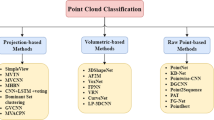Abstract
Early stopping techniques can be utilized to decrease the time cost, however currently the ultimate goal of early stopping techniques is closely related to the accuracy upgrade or the ability of the neural network to generalize better on unseen data without being large or complex in structure and not directly with its efficiency. Time efficiency is a critical factor in neural networks, especially when dealing with the segmentation of 3D point cloud data, not only because a neural network itself is computationally expensive, but also because point clouds are large and noisy data, making learning processes even more costly. In this paper, we propose a new early stopping technique based on fundamental mathematics aiming to upgrade the trade-off between the learning efficiency and accuracy of neural networks dealing with 3D point clouds. Our results show that by employing our early stopping technique in four distinct and highly utilized neural networks in segmenting 3D point clouds, the training time efficiency of the models is greatly improved, with efficiency gain values reaching up to 94%, while the models achieving in just a few epochs approximately similar segmentation accuracy metric values like the ones that are obtained in the training of the neural networks in 200 epochs. Also, our proposal outperforms four conventional early stopping approaches in segmentation accuracy, implying a promising innovative early stopping technique in point cloud segmentation.
Access this chapter
Tax calculation will be finalised at checkout
Purchases are for personal use only
Similar content being viewed by others
References
Bai, Y., et al.: Understanding and Improving early stopping for learning with noisy labels, June 2021 https://arxiv.org/abs/2106.15853v1
Bello, S.A., Yu, S., Wang, C., Adam, J.M., Li, J.: Review: deep learning on 3D point clouds. Remote Sens. 12(11), 1729 (2020). https://doi.org/10.3390/rs12111729
Caruana, R., Lawrence, S., Giles, L.: Overfitting in neural nets: backpropagation, conjugate gradient, and early stopping. In: NIPS’00: Proceedings of the 13th International Conference on Neural Information Processing Systems (2000). https://dl.acm.org/doi/10.5555/3008751.3008807
Chang, A.X., et al.: ShapeNet: an information-rich 3D model repository. arXiv (12 2015), http://arxiv.org/abs/1512.03012
Garcia-Garcia, A., Orts-Escolano, S., Oprea, S., Villena-Martinez, V., Martinez-Gonzalez, P., Garcia-Rodriguez, J.: A survey on deep learning techniques for image and video semantic segmentation. Appl. Soft Comput. 70, 41–65 (2018). https://doi.org/10.1016/j.asoc.2018.05.018
Guo, Y., Wang, H., Hu, Q., Liu, H., Liu, L., Bennamoun, M.: Deep learning for 3D point clouds: a survey. IEEE Trans. Pattern Anal. Mach. Intell. 43(12), 4338–4364 (2021). https://doi.org/10.1109/TPAMI.2020.3005434
Hegde, S., Gangisetty, S.: PIG-Net: inception based deep learning architecture for 3D point cloud segmentation. Comput. Graph. (Pergamon) 95, 13–22 (2021). https://doi.org/10.1016/j.cag.2021.01.004
Liu, W., Sun, J., Li, W., Hu, T., Wang, P.: Deep learning on point clouds and its application: a survey (2019). https://doi.org/10.3390/s19194188
Liu, Y., Fan, B., Xiang, S., Pan, C.: Relation-shape convolutional neural network for point cloud analysis (2019). https://doi.org/10.1109/CVPR.2019.00910
Prechelt, L.: Early stopping — but when? In: Montavon, G., Orr, G.B., Müller, K.-R. (eds.) Neural Networks: Tricks of the Trade. LNCS, vol. 7700, pp. 53–67. Springer, Heidelberg (2012). https://doi.org/10.1007/978-3-642-35289-8_5
Qi, C.R., Su, H., Mo, K., Guibas, L.J.: PointNet: deep learning on point sets for 3D classification and segmentation (2017). https://doi.org/10.1109/CVPR.2017.16
Qi, C.R., et al.: PointNet++: deep hierarchical feature learning on point sets in a metric space (2017). https://doi.org/10.5555/3295222
Thomas, H., Qi, C.R., Deschaud, J.E., Marcotegui, B., Goulette, F., Guibas, L.: KPConv: flexible and deformable convolution for point clouds, April 2019. https://doi.org/10.1109/ICCV.2019.00651
Yan, X., Zheng, C., Li, Z., Wang, S., Cui, S.: PointASNL: robust point clouds processing using nonlocal neural networks with adaptive sampling (2020). https://doi.org/10.1109/cvpr42600.2020.00563
Yi, L., et al.: A scalable active framework for region annotation in 3D shape collections. ACM Trans. Graph. 35(6) (2016). https://doi.org/10.1145/2980179.2980238
Ying, X.: An overview of overfitting and its solutions. J. Phys. Conf. Ser. 1168(2), 022022 (2019). https://doi.org/10.1088/1742-6596/1168/2/022022
Zhang, J., Zhao, X., Chen, Z., Lu, Z.: A review of deep learning-based semantic segmentation for point cloud. IEEE Access 7, 179118–179133 (2019). https://doi.org/10.1109/ACCESS.2019.2958671
Zoumpekas, T., Molina, G., Puig, A., Salamó, M.: CLOSED: a Dashboard for 3d point cloud segmentation analysis using deep learning. In: Proceedings of the 17th International Joint Conference on Computer Vision, Imaging and Computer Graphics Theory and Applications, pp. 403–410 (2022). https://doi.org/10.5220/0010826000003124
Zoumpekas, T., Molina, G., Salamó, M., Puig, A.: Benchmarking deep learning models on point cloud segmentation. In: Artificial Intelligence Research and Development, vol. 339, pp. 335–344, October 2021. https://doi.org/10.3233/FAIA210152
Acknowledgements

This project has received funding from European Union’s Horizon 2020 research and innovation programme under the Marie Skłodowska-Curie grant agreement No 860843.
Author information
Authors and Affiliations
Corresponding author
Editor information
Editors and Affiliations
Rights and permissions
Copyright information
© 2022 The Author(s), under exclusive license to Springer Nature Switzerland AG
About this paper
Cite this paper
Zoumpekas, T., Salamó, M., Puig, A. (2022). Effective Early Stopping of Point Cloud Neural Networks. In: Torra, V., Narukawa, Y. (eds) Modeling Decisions for Artificial Intelligence. MDAI 2022. Lecture Notes in Computer Science(), vol 13408. Springer, Cham. https://doi.org/10.1007/978-3-031-13448-7_13
Download citation
DOI: https://doi.org/10.1007/978-3-031-13448-7_13
Published:
Publisher Name: Springer, Cham
Print ISBN: 978-3-031-13447-0
Online ISBN: 978-3-031-13448-7
eBook Packages: Computer ScienceComputer Science (R0)




